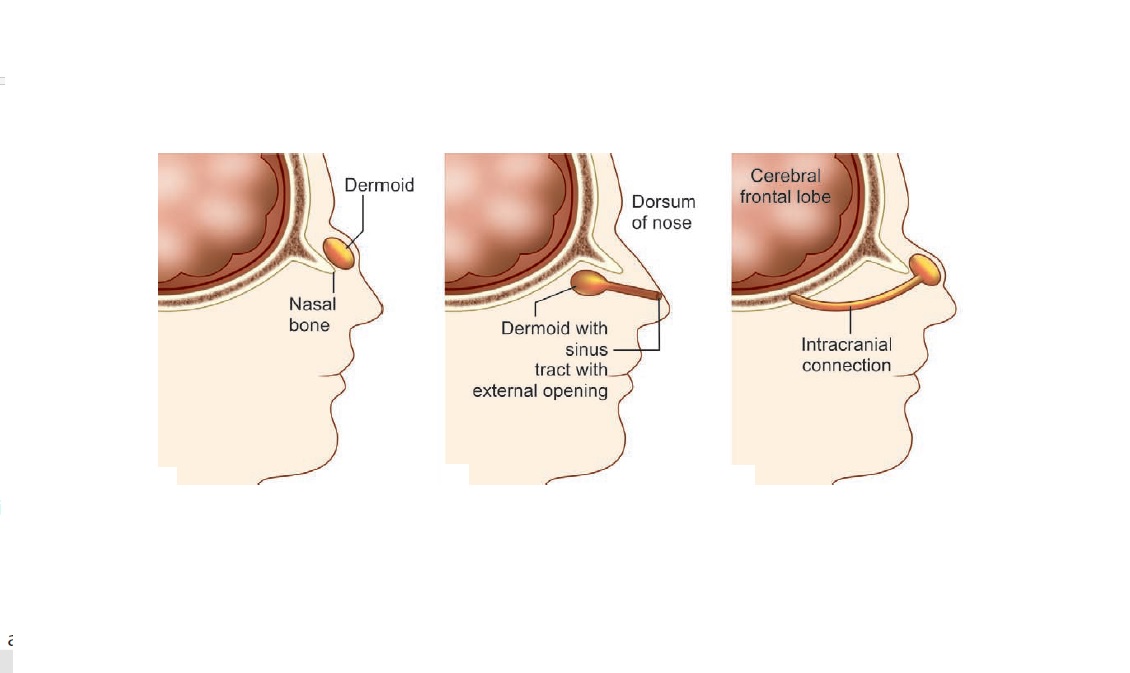Definition:
A dermoid cyst is the most common midline nasal mass, usually seen in any position from the nasal tip to the glabella.
It occurs along the lines of fusion of the body parts.
They may be associated with a sinus or a tuft of hair in the punctum.
An intracranial extension has to be ruled out before any manipulation is done.
It may be present at birth or present after the first decade of life when secondarily infected.
It may be associated with other anomalies of the nose.
HYPOTHESIS
It is thought to result due to inadequate closure of the fonticulus frontalis, which allows dermal tissue to extend between the nasal bone and cartilage.
Another hypothesis is that –
Dermoid cysts result due to the persistence of residual dura in the prenasal space.
The prenasal space is in the midline between the developing nasal bone and underlying cartilage from the brain to the nasal tip.
The misplaced dura forms contact with the skin, and then it retracts to result in a sinus. A cyst may develop in this.
Types of DERMOID CYSTS
Dermoid cyst of the nose can be:
Intranasal or Extranasal
The common site for extra nasal presentation is the nasal dorsum
Symptoms
Slow-growing midline mass over the nasal dorsum.
It can be painless if it is secondarily infected.
Signs
Firm, smooth surface, fluctuating, cystic, well-defined margins,non-compressible mass with negative Furstenberg test, and transillumination is negative.
Furstenberg sign is a clinical feature of masses of the head that communicate with the intracranial compartment. Due to this connection, an increase in intracranial pressure will result in bulging or swelling of the mass. This can occur spontaneously during crying or can be elicited with a Valsalva maneuver or compression of the internal jugular veins.
The usual site is the dorsum of the nose. Infection of the dermoids results in abscess formation resulting in tender swelling.
Complication
Infection of Dermoid Cyst can lead to —
- Abscess formation
- Intermittent infection
- Osteomyelitis
- Nasal obstruction
- Meningitis
- Cerebral abscess and Dealing with DERMOID CYST of the Nose: Learn about causes, symptoms, and treatment options. Get expert insights on handling dermoid cysts effectively
- Association with CNS defect.
Investigation
CT SCAN is the imaging modality of choice to detect the bony defect.
MRI SCAN is to rule out meningoencephalocele.
Treatment
Early surgery is advised to prevent infection, expansion of the cyst, and destruction of adjacent tissues.
Management is with surgical excision of the dermoid. The approach depends on the position of the cyst.
If it is in the lower half of the nose, an open rhinoplasty provides a good assessment, and in case it is higher up, direct excision is better.
Excision of the sinus tract may necessitate medial or lateral osteotomy.
In case of intracranial extension, a combined intracranial/extracranial procedure is recommended.
THANK YOU
MEDICAL ADVICE DISCLAIMER:
This blog including information, content, references, and opinions is for informational purposes only.
The Author does not provide any medical advice on this platform.
Viewing, accessing, or reading this blog does not establish any doctor-patient relationship.
The information provided in this blog does not replace the services and opinions of a qualified medical professional who examines you and then prescribes medicines.
And if you have any questions of medical nature, please refer to your doctor or qualified medical personnel for evaluation and management at a clinic/hospital near you.
The content provided in this blog represents the Author’s own interpretation of research articles.
